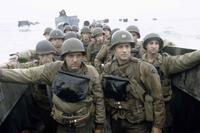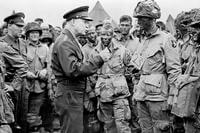One of the perennial debates among military historians and armchair generals revolves around Adolf Hitler's decision to directly control the disposition of the Panzer units in northern France in the period immediately preceding the Normandy landings.
The basic elements of the debate are well known. The question is, would a different deployment of the Panzer units have affected the outcome of D-Day? Specifically, had Hitler followed Field Marshal Erwin Rommel's plan to station the Panzer units forward along the coast, would the Germans have successfully repulsed the Allied landings in Normandy?
By the autumn of 1943, it was clear that the Allies were planning to invade Western Europe. The precise location, however, was still being debated. British Prime Minister Winston Churchill had suggested southern France or Greece as possible landing sites. The U.S. was urging a landing in northern France, as that would offer the shortest route to Nazi Germany and the Ruhr, its industrial heartland. Soviet dictator Joseph Stalin, anxious for a second front, concurred. Eventually, Churchill agreed to support a landing in northern France.
In October, Hitler transferred Rommel and the staff of Army Group B from northern Italy to France. Rommel was put in charge of strengthening the Atlantic Wall, a series of fortifications that ran from Norway to the Pyrenees. Initially, Army Group B (15th Army and 7th Army) reported directly to Hitler. In January 1944, however, it was placed under the command of Field Marshal Gerd von Rundstedt, who was Commander in Chief West. Rundstedt also had Army Group G (1st and 19th Army), which was responsible for the defense of France south of the Loire.
RELATED: A Bodyguard of Lies: How the Allies Deceived Germany about D-Day
All of the armored forces in the west, however, were separate from Rundstedt's command. They were organized into Panzer Group West, under the command of Gen. Leo Geyr von Schweppenburg, and reported directly to Hitler. Panzer Group West consisted of the 2nd, 21st, 116th, 1st SS, 12th SS, 17th SS, 2nd SS, 9th and 11th Panzer Divisions. In reality, von Schweppenburg also reported to von Rundstedt, but any operational deployment of the Panzer divisions had to be confirmed by Hitler himself.
Rommel believed that the Allied landings would come somewhere between Dunkirk and the mouth of the Somme River, with the most likely area being between Calais and Boulogne-sur-Mer. This area was well to the north of the Normandy beaches. Moreover, the Seine River separated this zone from Normandy.
The delta at the mouth of the Seine was large, and the entire length of the river from Rouen to Le Havre, at the river's mouth, was marshy. Moving vehicles between the two zones would often require backtracking some 50 miles inland and going through Rouen. Moreover, some of the bridges across the Seine could not handle the weight of the Panzers or their transport vehicles, further complicating the transfer of equipment between the two zones.
Germany military doctrine called for a threefold approach to the Normandy landings: a mobile defense in depth, augmented by significant local striking power to hold the allied invaders in check until a mobile strategic reserve could be brought to bear for a decisive counterattack and a battle of annihilation. The mobile reserve would be positioned well to the rear of the front line to prevent it from being committed prematurely and allowing it to be directed in a rapid thrust against the main force's weak points.
This doctrine had worked spectacularly well on the Eastern Front in 1941, allowing German Panzer divisions, and their supporting mechanized infantry, to break through weak points in the Soviet lines and then execute giant pincer movements to envelop the opposing forces. In this way, entire Russian armies had been surrounded and decimated during the initial German thrust into the Soviet Union during the summer of 1941.
Rommel took issue with this approach. First, based on his experience against Allied forces in North Africa, he believed that Allied control of the air would hamper the movement of the Panzer divisions from rear areas to the front lines. Tanks would have to move under cover of darkness or when weather conditions made flight operations impossible. In Rommel's view, a strategic reserve would come under attack from Allied air and naval forces long before it could be brought to bear for a counterattack against Allied troops holding the beachheads.
Moreover, Rommel argued that the French coast was completely different from the flat terrain on the Eastern Front that had allowed the rapid movement of massed armored columns. The coastal areas consisted of a combination of marshy ground, broken up by hills and heavily wooded terrain. The flatter pasture areas, where tanks could have operated well, were bisected by hedgerows, fence lines formed by closely spaced lines of ancient trees and shrubs, and heavily wooded copses. In this terrain, Rommel believed it would be difficult to mass armored units to deliver a killing blow to Allied forces.
Instead, Rommel argued that the invasion force had to be destroyed in the water and on the beaches, where they would have little cover or fire support. His proposed strategy consisted of static defense along the coasts, backed by concrete pillboxes and overwhelming firepower. Rommel wanted to deploy the Panzer units to support the infantry as a local tactical force that could strike against weak points in the Allied line, and could be deployed to seal any breaches in the German lines. He believed, correctly, that it would take the Allies some time to build up their tank strength on the beaches and that, in the first 48 hours of the landings, the Germans would have an overwhelming advantage in armor.
Rommel asked that the 12th SS Panzer Division, for example, be stationed at Isigny rather than at Evreux. That would have placed it less than 10 miles from Omaha Beach rather than roughly 110 miles to the east. Both von Rundstedt and von Schweppenburg disagreed. So did Heinz Guderian, the Inspector General of Armored Troops and an architect of the Blitzkrieg concept of using massed tank formations to deliver a decisive blow to an opposing force.
Rommel appealed over their heads directly to Hitler. Rather than siding with Rommel or von Rundstedt, Hitler chose to accommodate both requests, satisfying neither. The 2nd, 21st and 116th Panzer Divisions were assigned to Army Group B and put under Rommel's direct command. Panzer Group West retained the 1st SS, 12th SS, 17th SS and Lehr Panzer Divisions, while 2nd SS, 9th SS and 11th Panzer Divisions were transferred to Army Group G.
In the end, the only Panzer division that saw any significant action during D-Day was the 21st Panzer Division near Caen. It played a critical role in thwarting the Anglo-Canadian attack on the town, and allowed German reinforcements enough time to secure it. The battle for Caen, originally expected to take only one or two days, would last instead for two months. The town would not fall to the allies until Aug. 6, 1944.
When news of the Allied landings reached Hitler, he was at the Berghof, his private home near Berchtesgaden, in the Bavarian alps. He did not receive news of the Allied landings until after he had woken up around noon. His staff had been unwilling to disturb him. Initially, Hitler dismissed the landings as a feint. Eventually, at 4 p.m. that afternoon, Hitler released two divisions of Panzer Group West, the 12th SS and Panzer Lehr, for deployment to the coast.
By June 7, they were at Caen, where they participated in the defense of the town. Germany had roughly 1,400 tanks in theater at the beginning of the Normandy invasion. Roughly 400 were south of the Loire with Army Group G. Of the balance remaining in northern France, less than 400 saw any action within the first 48 hours of the Allied invasion.
Excluding the three Panzer divisions transferred to Army Group G, Rommel could have ended up controlling seven Panzer divisions instead of three. Would that have made a difference in the outcome of the D-Day landings? That depends on how Rommel would have deployed them.
Of the three that he did control, only one was deployed in Normandy; the other two were farther north toward Calais. It took several days before any armor units from those divisions made their way to Normandy. Despite his insistence on controlling the Panzer divisions, most of the tanks that engaged Allied forces in the first 48 hours of the D-Day landings were ones that had been part of the reserve force of Panzer Group West.
Rommel expected that the Allied landings would take place north of the Seine delta, and presumably would have deployed most of the Panzers there. We'll never know how Rommel might have employed the additional Panzer units, but it's likely that only one, at most two, would have ended up near the Normandy landings. The balance would have been further north, where Rommel expected the landings to occur.
Rommel remains highly admired as a brilliant tactician and commander. He redeemed himself, in part, for his role in Valkyrie, the failed plot to kill Hitler.
Adolf Hitler, on the other hand, is typically dismissed as militarily incompetent and whose involvement in military operations hampered the German war effort.
Rommel was right in arguing that Allied air power would hinder the movement of the Panzer divisions, and that concentrating the armored divisions for a lethal counterattack wouldn't work in the terrain of Normandy and Brittany. On the other hand, by deploying the Panzer units before the location of the landings was known, Rommel effectively took them out of contention in the critical 48 hours after the landings started.
In retrospect, holding the Panzer divisions in reserve and then rushing them to support individual infantry units, rather than massing them for a counterattack, would have been the best strategy, even if Allied air power would have taken its toll on the tanks. That could have been a logical compromise between Rommel and von Rundstedt but, when Rommel went around the chain of command, he made such a compromise impossible. What he ended up with, fortunately for the Allies, was the worst of both worlds.
Rommel's mistake in deploying his Panzer units was the result of an elaborate British subterfuge -- Operation Fortitude. That's the topic of my next column.
Joseph V. Micallef is a best-selling military history and world affairs author, and keynote speaker. Follow him on Twitter @JosephVMicallef.
-- The opinions expressed in this op-ed are those of the author and do not necessarily reflect the views of Military.com. If you would like to submit your own commentary, please send your article to opinions@military.com for consideration.

























